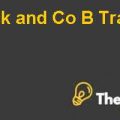Eyewitness Surveillance II Case Study Help
Introduction
In the complex world of mergers and acquisitions, strategic decisions often hinge on a careful evaluation of key factors. This case study delves into the intricate negotiation process surrounding the acquisition of Eyewitness Surveillance by RT Arnold and Rush McCloy. Central to their deliberations was the pivotal role of Vince Redland, the company's co-founder and driving force behind its success.
As Arnold and McCloy contemplated the potential fallout of Redland's exit and assessed the significance of his contributions, they grappled with the decision to attempt to convince him to re-engage to complete the transaction. This multifaceted decision encompassed considerations of business continuity, legal and financial implications, governance structures, risk mitigation, and the alignment of their long-term strategic vision. The case explores the intricate interplay of these factors and the ultimate determination of whether re-engagement was a prudent course of action.
Situational Analysis
(Thoughts on Eyewitness’ Business Model and Growth Prospects)
The Eyewitness Surveillance business model and growth prospects appear to be promising based on the preliminary information provided. Here are the thoughts on whether to pursue this acquisition.
Positive Aspects
Eyewitness Surveillance's reliance on recurring monthly revenue (RMR) is a significant strength. It indicates a steady stream of income, which is often more predictable and less susceptible to market fluctuations. The company has demonstrated consistent and substantial growth in RMR, run-rate revenue, and run-rate EBITDA over the past few years. A 53% growth in RMR in the last 12 months is particularly noteworthy.
The business model appears to be cost-efficient, with a lower cost structure compared to traditional security guard services. This cost advantage could provide a competitive edge. Eyewitness Surveillance serves automotive dealerships, a sector with specific security needs. With a high percentage of customers in areas with significant crime scores, there seems to be a strong market demand for their services.
Concerns and Considerations
The limited access to Eyewitness Surveillance's proprietary software and technology is a significant concern. Understanding the technology stack and its robustness is critical for long-term sustainability. The reliance on Vince Redland for sales and customer relationships poses a potential risk. A successful transition of these responsibilities would be essential.
The attrition adjustment clause in the purchase agreement became a point of contention, indicating potential disagreements and complexities in the negotiation process. The limited due diligence process and access to customers and employees raise questions about the depth of understanding of the business before the acquisition.
Pursued Acquisition based on Preliminary Information
After a detailed analysis, it is clear that Eyewitness Surveillance II presents both opportunities and challenges. Based on the preliminary information, it would consider pursuing the acquisition of Eyewitness Surveillance with caution. While the recurring revenue model, growth, and market demand are appealing, the limited access to technology and potential challenges in the negotiation process are red flags.
A comprehensive due diligence process, including a thorough assessment of the technology, customer relationships, and employee dynamics, would be essential before making a final decision. The potential for long-term success would heavily depend on effective post-acquisition management and the ability to address the identified concerns.
(Evaluation of Arnold and McCloy's Decisions and Actions)
Arnold and McCloy's decisions and actions regarding due diligence of the employee base, customers, and technology in the Eyewitness Surveillance II case can be assessed as follows:
Employee Base Due Diligence
Arnold and McCloy's approach to employee base due diligence exhibited both positive actions and concerns. They acknowledged the significance of understanding the workforce and attempted to meet with employees before closing the deal, which was a proactive step. Furthermore, considering employee interviews demonstrated their commitment to assessing employee sentiments and dynamics.
However, their decision to limit employee access until after confirming funds and signed agreements may have restricted their ability to obtain a comprehensive view of potential workforce issues. Additionally, they did not delve deeper into concerns raised by Karlis Beltzin, the director of IT, about trust and relationships within the organization, missing a crucial opportunity to uncover critical workforce challenges.
To conduct more effective employee due diligence, Arnold and McCloy could have insisted on more comprehensive access to employees earlier in the process to assess overall morale, trust, and dynamics within the organization. Conducted confidential interviews with key employees, including Karlis Beltzin, to understand their concerns and identify potential red flags regarding the workforce. These interviews could have been conducted with the assurance of confidentiality to encourage candid feedback............
Eyewitness Surveillance II Case Study Help
This is just a sample partial case solution. Please place the order on the website to order your own originally done case solution.













